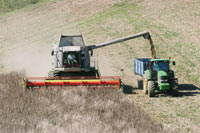Pulses play a key role in health of planet

Peas and beans have an increasingly important role to play in the battle to reduce greenhouse gases and keep the planet and its people healthy, delegates at last week’s HGCA & PGRO Oilseeds and Pulses conference heard.
As fertiliser prices surged, legumes’ ability to grow well without manufactured nitrogen fertiliser was a significant point, explained the PGRO’s Salvador Potter.
“With the N in ammonium nitrate costing north of £1/kg it’s worth remembering that pulses don’t need artificial N,” he said. Indeed such crops did not benefit from its addition.
Outlining the fixation process whereby they made their own N supplies using rhizobium bacteria in the roots Mr Potter noted that like fertiliser manufacture it was energy-intensive. “Up to a third of the plants’ photosynthetic energy is used to drive the process.”
However, it was worth noting that the Intergovernmental Panel on Climate Change had recently ruled that such fixed nitrogen would no longer be included in accounting for greenhouse gases.
Highlighting Canada’s success since the mid-1970s with Canola oilseed rape the country’s “Cinderella crop” farmer and Pulse Canada director Mike Donnelly-Vanderloo saw a good future for pulses. “I like to think that pulses are the Cinderella in waiting.”
Launches of food products with claimed health messages were steadily increasing, and pulses met many of those market needs and addressed key issues such as obesity, diabetes, heart disease and colon cancer, he explained.
Last year 45% of new processed foods worldwide contained health and nutrition messaging up from 31% in 2002, he noted. “We hope to capitalise on this. Pulses are a nice fit.”
SAC researcher Jos Houdijk acknowledged that most UK pulses were grown for human consumption. But the country’s pig industry used large amounts of imported soya bean meal which could, if specific constraints were overcome, be replaced by home-grown pulses as both a source of protein and energy and so save “feed miles”.
The main drawbacks were the crops’ nutritional quality, and a new 3.5-year LINK project Green Pig began last July to examine ways to overcome these, he explained.

